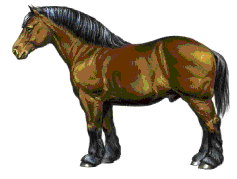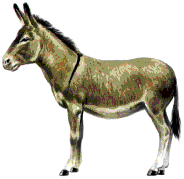
Many people thought about evolution but the first person to actually study and make an accurate report about evolution was Darwin in 1859. His theory was
based on natural selection, which states the following:
a) Most plants and animals produce offspring that show that their genes are not exactly like their forefathers
b) Some species produce many offspring and only a few survive.
c) Others produce few offspring but give a lot of attention to their children. Some types of offspring are able to survive better than other, and those that survive eventually dominate.
According to natural selection, the environment is the one who selects. Environment changes over time and different category will be selected at different times. Survival of the fittest refers to the number of offspring.

There are other theories for evolution. "Punctuated Equilibrium" has long periods with little or no change with short periods of rapid change.
The first types of horses were called the Hyracotherium. It was a small herbivore and lived in North America about 60 million years ago and later it spread across Europe and Asia. Fossil remains of the Hyracotherium really show how they differ from modern horses today. It was much smaller than a modern horse, had well developed digits (four toes on the forefoot, three toes on the hind foot), and had a low-crowned molar teeth making it have less of the serrated surface which is very typical for the modern horse. People nowadays know that the Hyracotherium lived in a rather marshy, well-wooded country. It fed on soft vegetation, and fruits, for which its non-grinding teeth (molars) would be perfectly fitted for.
Approximately 20 million years later, there were the Mesohippus. It was very similar to the Hyracotherium . It had similar molars, and lived in the same environment. The only difference was that it was approximately 20cm bigger and its 5th toe (metacarpal) was very short. The third metacarpal grew bigger and was sticking out from the foot more so that most of the weight was set on it.
As we come to the Merychippus (about 30 million years ago) we see a great change in the Molar teeth. The cement surrounds the Molar totally, which is different to the previous two horses because by them, the cement only covers the bottom ends. The Molars have become bigger, especially the "dentine" and the "enamel". We also see that two toes have drawn themselves up to the ankle. Now the only effective toe is the "hoof"
Evolving along with the modern horse were other species of Equus, such as the Ass , or donkey , the onager , and the various zebras . Hybrids of the horse and the donkey include the Mule , the offspring of a male donkey and a female horse, and the Hinny , the offspring of a male horse and a female donkey.
Many people say that the Pliohippus that dates from 10 million years ago looks very similar to the Zebra. At this stage the Pliohippus has most of the features like the modern horse (Equus ). It is about the same size as the Merychippus (approximately 1 meter) All of the toes seem to have disappeared except the "Hoof" which is the main part of the foot for modern horses. One knows knows that the conditions and the atmosphere these horses live in are different, due to the Molar. We can see that the horses diet has changed from soft vegetation, and fruits (for which its non-grinding teeth, molars, would be perfectly fitted for at that time) to grass and hay.
A modern horse named the Equus . Through its molars we learn that they live in plain areas, and feed on grass and hay. The very first Equus appeared about 1 million years ago. It is bigger than the Pliohippus , (1.6 m) and its molars are much bigger. The "enamel" and the "dentine" have covered most of the molar teeth. The "hoof" is much bigger, takes a wider area.

What we lean is that the Hyracotherium is very different to the Equus . At first the Hyracotherium started out with five toes and as we approach the Equus only the "hoof "is left. One can really see evolution take place in the horse. What we learn with the changes are that their living conditions have changed quite a lot, as a new species evolves. Through evolution we see what types of vegetation they feed on .
© 1999, Ahsan T. , Vienna , Austria